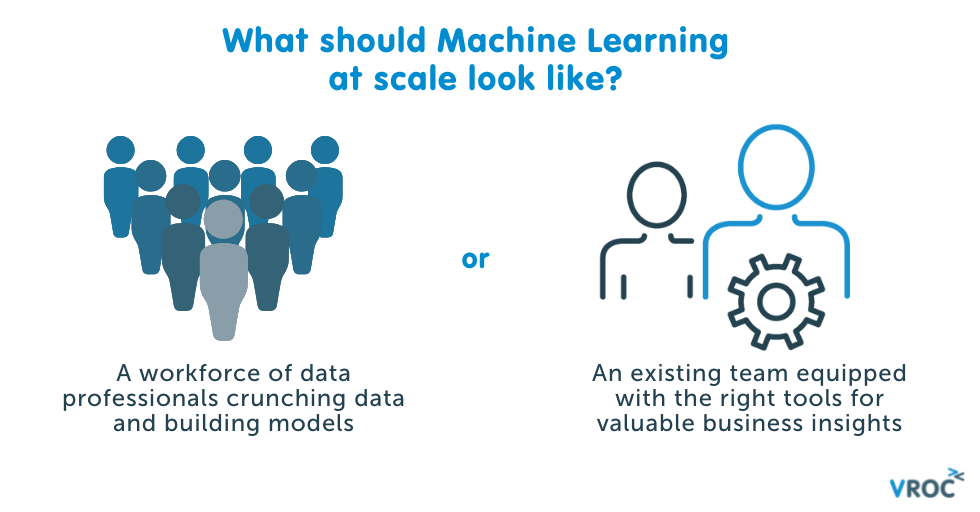The deployment of traditional machine learning (ML) models requires a lot of manual intervention, which is manifested in complex tasks like data pre-processing, feature engineering, model selection, hyperparameter optimization, and model post-processing. However, a survey by Deloitte showed that only 8% of business decision makers considered their companies’ ML programs to be sophisticated.(1) AutoML and MLOps are both attempting to automate some of these complex tasks to improve the effectiveness and efficiency of machine learning.
Automated machine learning (AutoML) emblematizes a fundamental shift in the way businesses of all sizes approach machine learning and data science. It attempts to automate the complex tasks so that subject matter experts can produce their own models, targeting specific outcomes and rapidly analyzing the results without manual coding and programming.
Machine learning operations (MLOps) on the other hand acts as a communication protocol between data scientists and the It Operations team. Its main purpose is to eliminate model waste, improving efficiencies in the process from model generation to deployment, so that businesses can generate more consistent insights. MLOps aims to accelerate the entire model life cycle process, with a market predicted to expand to nearly US$4 billion by 2025.
Manually constructing a machine learning model is a long multiplex journey that demands domain knowledge, mathematical expertise, and computer science skills from a data scientist (usually more than one). In addition, there are high possibilities of human error and bias which might occur, degrading model precision and devaluing the insights which could be obtained from the model.
AutoML enables engineers and subject matter experts to access the benefits of advanced analytics without the need of specialized machine learning or data science knowledge and allows an organization’s data scientist to focus on more complex problems. This provides an opportunity to leverage existing data, increasing the return on investment by reducing the time to capture insights across a greater number of problem statements, while eliminating human errors and biases.
There are four ways that businesses can benefit with the use of both autoML and MLOps:
The lack of expertise to develop AI and ML models has hindered the further expansion of machine learning, as companies struggle to recruit people with both domain knowledge and skills to build different models. With autoML, domain experts can now participate in building AI models. Enterprises no longer need to be limited by the availability and cost of recruiting highly specialized talent and can focus on speed of innovation and scalability.
In many industries, shorter time to market can provide a huge competitive advantage. AutoML & MLOps reduces the time it takes to build models; and can accelerate the time to process data and produce results up to 2000X faster than traditional approaches. A survey reported that ML deployments happen too slowly, with 22% saying it takes between one to three months, while another 18% say it takes more than three months.(2) MLOps can automate the operationalization of the models, and provide a faster route to success.
Building machine learning models from scratch manually and deploying them successfully into a live environment requires a lot of time and money. A large part of the cost is attributed to data scientists and other machine learning experts time and effort. AutoML allows for the democratization of data throughout the organization, not just to highly specialized personnel. MLOps allows for the deployment of these models, their management and maintenance with minimum personnel. By automating the development process OPEX costs can be greatly reduced.
Some AutoML platforms, like OPUS, automates data processing and data manipulation, producing models faster across multiple parameters, easily handling large data volumes. It allows you to produce multiple iterations to test assumptions rapidly. With MLOps, you can productionize the models easily with constant monitoring, model insights and production diagnostics. Together, they assist you in rapidly obtaining valuable insights from your data in a live environment, which can lead to improvement in business decisions.
Despite of the efforts in ML adoption by many organizations, IDC reported that 28% of AI/ML projects failed due to lack of necessary expertise, production-ready data, and integrated development environments.(3) Therefore, an end-to-end fully automated AI solution, which combines AutoML functionality with MLOps capabilities like OPUS by VROC, can be pivotal to helping organizations scale their AI efforts for improved business outcomes and a competitive advantage.
References:
1. MLOps landscape and industrial AI | Deloitte Insights

Why data quality, silos, delays and dark data could be stalling your digital transformation
Read ArticleEmpowering decision making and operational efficiency with AI on an offshore platform in Central Asia.
Read ArticleInterested in a demo of one of our data solution products?
DataHUB4.0 is our enterprise data historian solution, OPUS is our Auto AI platform and OASIS is our remote control solution for Smart Cities and Facilities.
Book your demo with our team today!
Ready to embark on a pilot project or roll-out AI innovation enterprise wide? Perhaps you need assistance integrating your systems or storing your big data? Whatever the situation, we are ready to help you on your digital transformation.
The efficient deployment, continuous retraining of models with live data and monitoring of model accuracy falls under the categorisation called MLOps. As businesses have hundreds and even.
Learn more about DataHUB+, VROC's enterprise data historian and visualization platform. Complete the form to download the product sheet.
Discover how you can connect disparate systems and smart innovations in one platform, and remotely control your smart facility. Complete the form to download the product sheet.
'OPUS, an artistic work, especially on a large scale'
Please complete the form to download the OPUS Product Sheet, and discover how you can scale Auto AI today.
Interested in reading the technical case studies? Complete the form and our team will be in touch with you.
Subscribe to our newsletter for quarterly VROC updates and industry news.